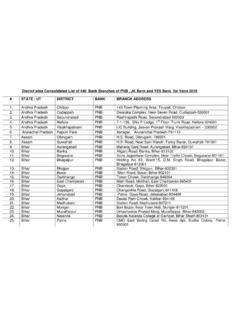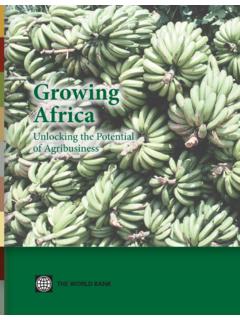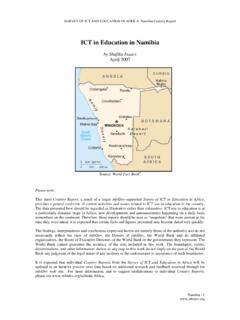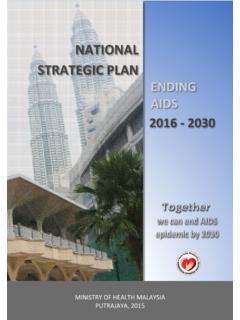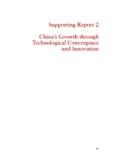Transcription of Investing in African Livestock: business …
1 Investing in African livestock : business opportunities in 2030-2050. March 2013. livestock Data Innovation in Africa Project A joint initiative of the World bank , FAO, ILRI, AU-IBAR with support from the Bill and Melinda Gates Foundation AKNOWLEDGEMENTS AND DISCLAIMERS. This paper was prepared by a core team composed of Ugo Pica-Ciamarra, FAO (team leader), Derek Baker (ILRI), Nancy Morgan (FAO), Cheikh Ly (FAO) and Simplice Nouala (AU-IBAR). The authors thank the FAO Global Perspective Studies Unit for providing the data for the analysis, as well as for comments on previous drafts of this work. The designations employed and the presentation of material in this information product do not imply any opinion whatsoever on the part of the Food and Agriculture Organization of the United Nations (FAO), the International livestock Research Institute (ILRI) nor the African -Union Interafrican Bureau for Animal Resources concerning the legal or development status of any country, territory, city or area or of its authorities, or concerning the delimitation of its frontiers or boundaries.
2 The views expressed in this information product are those of the authors and do not necessarily reflect the views or policies of FAO, ILRI or AU-IBAR. 2. EXECUTIVE SUMMARY. This paper depicts the medium to long term development prospects for the African livestock sector by reviewing data on the estimated consumption of animal-sourced foods and anticipated responses by producers for 2005/07, 2030 and 2050. Data and projections are elaborated by the FAO Global Perspective Studies Unit. Increases in the demand for animal-sourced food are estimated extraordinarily high in Africa over the coming decades. By 2050, the meat market is projected at million tonnes and that of milk about million tonnes, an increase of 145 and 155 percent respectively over 2005/07 levels.
3 More notably, over this period, Africa's increase in volume of meat consumed will be on a par with that of the developed world and that of Latin America, with only South Asia and Southeast Asia anticipated to register higher growth. For milk, only South Asia will register stronger gains in market size than Africa. Furthermore, annual growth rates in both meat and milk consumption are projected to be higher in Africa than in other regions, with the exception of meat in South Asia (from a very low base). Within Africa, beef, milk and poultry are anticipated to provide favourable business opportunities for livestock producers, in both volume and value terms. However, market dynamics differ amongst the geographic hubs, including Western and Southern Africa; Northern and Southern Africa; and Central Africa.
4 Production will not keep pace with consumption. Africa is anticipated to increasingly become a net importer of animal-sourced foods. This represents a missed development opportunity, given the widespread societal benefits that inclusive growth of livestock can generate, particularly in a continent where the majority of rural dwellers depend fully or partly on livestock for their livelihoods. Consequently, investments, and policy and institutional reforms that target African livestock markets are required to ensure that the business opportunities generated by the growing demand for animal-sourced foods translate into widespread benefits for the population. Formulating effective livestock sector policies and institutional changes require a flow of information on market conditions and on the constraints to market entry.
5 These are rarely readily available and investments in data collection and in data collection systems should be given appropriate priority, as the basis for supportive policies and investment. 3. INTRODUCTION. Medium and long-term development perspectives of any productive sector are driven by prospects for demand growth which, dependent on the policy and economic environment, can translate into associated producer responses. For the livestock sector, trends in the consumption of animal- sourced foods and livestock by-products are the first key indicator of opportunities for investment. If consumption of meat, milk, eggs and other livestock by-products are increasing, opportunities and incentives for investments will be forthcoming, including business opportunities for producers.
6 If, however, consumption growth is negative or low, there will be few investment incentives for producers. This paper portrays the medium to long term development prospects for the African livestock sector by presenting data on the actual and projected consumption of animal-sourced foods and anticipated responses by producers for 2005-07, 2030 and 2050. Data and projections are derived from analysis undertaken by the FAO Global Perspective Studies Unit (see Alexandratos and Bruinsma, 2012). This analysis shows that increases in the demand for animal-sourced food are projected to be extraordinarily high in Africa in the coming decades, but that production will not keep the pace of consumption: indeed, the continent is anticipated to increasingly become a net importer of animal-sourced foods.
7 This is a missed development opportunity, given the widespread societal benefits that inclusive growth of livestock can generate, particularly in a continent where the majority of rural dwellers partly or fully depend on livestock for their livelihoods (FAO, 2012). Policy and institutional reforms should be devised, building on solid data and evidence based analysis, to ensure that the business opportunities generated by the growing market for animal- sourced foods translate into widespread benefits for the populace, including livestock producers, and for other actors along the value chains as well as consumers. The following section reviews African trends in the consumption of livestock products compared to other major world's regions, as well as positioning these trends within the evolving trade position of the African continent.
8 Sections three and four compare animal protein trends in consumption and trade of the different animal products for the continent as a whole, and among the continent's major geographic regions. Section five discusses the opportunities presented by investments in livestock , while focusing on the required enabling underlining policies and supportive data and information. African livestock MARKETS IN THE GLOBAL CONTEX T. In the developing world, gains in real per capita income, rapid population growth and urbanization have been sustaining major increases in the consumption of livestock products, a phenomenon dubbed the livestock Revolution' (Delgado et al., 1999). In recent decades, consumption of animal- sourced foods has primarily increased in Latin America, South Asia and Southeast Asia, with Africa lagging behind (Pica-Ciamarra and Otte, 2010).
9 But Africa is gradually catching up. In 2010 and 2011. the continent recorded GDP growth rates of and percent respectively and, according to the Economic Report on Africa 2012 a joint publication of the African Union and the United Nations Commission for Africa growth rates are projected to rebound to over 5 percent in the coming 4. years. By 2030, African GDP will be four times its 2010 level (UNECA and AU, 2012). Similarly, by 2030 Africa's population will be over billion, up from about 1 billion in 2010, with almost 48. percent of people in the continent living in urban areas vis- -vis 39 percent in 2010 (UN 2011 and 2012). These conditions seem to be conducive to a livestock Revolution' unfolding in Africa in the coming years.
10 Figures 1 and 2 present three basic measurements of African meat and milk markets compared to those of other major regions for 2005/07, 2030 and 20501. These indicators are: Market size, as measured by the volume of current (2005/07) and projected consumption of livestock products in 2030 and 2050. Market growth, as measured by the additional volume of animal sourced-foods consumed from 2005/07 to 2030 and to 2050. Market growth, as measured by the annual growth rate in consumption of livestock products over the reference period. Fig. 1. Estimated and projected size of meat markets in world's regions, 2005-07, 2030 and 2050. Estimated consumption 2005/07, million tons Growth, million tons Estimate consumption Annual growth rate 2005/7-2030 2030-50 2050 2005/07 - 2050.










